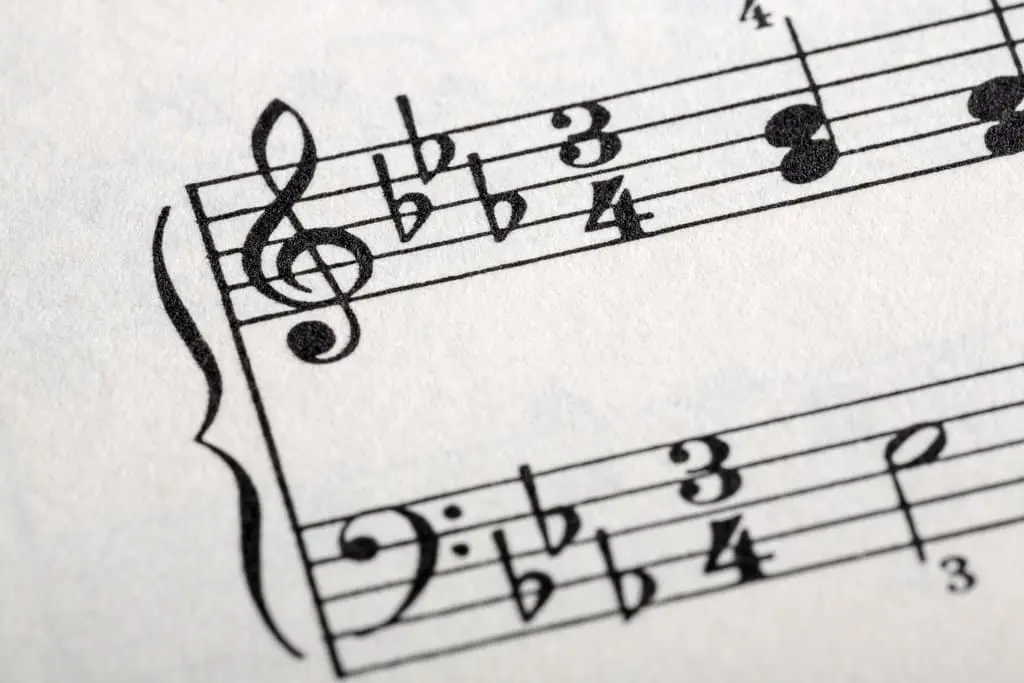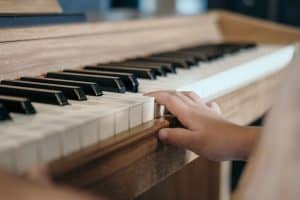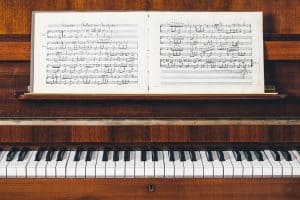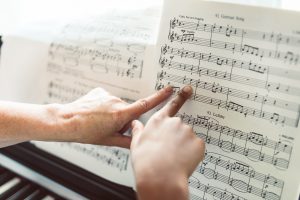Ever noticed those two stacked numbers at the beginning of sheet music and wondered what they mean? They’re called time signatures, and understanding them is essential for keeping the beat and making music. Let’s explore how they help musicians play, read, and interpret music more effectively.

What are time signatures?
Time signatures, or meter, are the notations in sheet music that guide the rhythmic structure of a piece. They appear at the start of a piece of music, with the clef and key signature, to let musicians know how to count before they start playing. They give instructions on how to divide and feel the rhythmic pulse of a tune ensuring written sheet music sounds as intended.
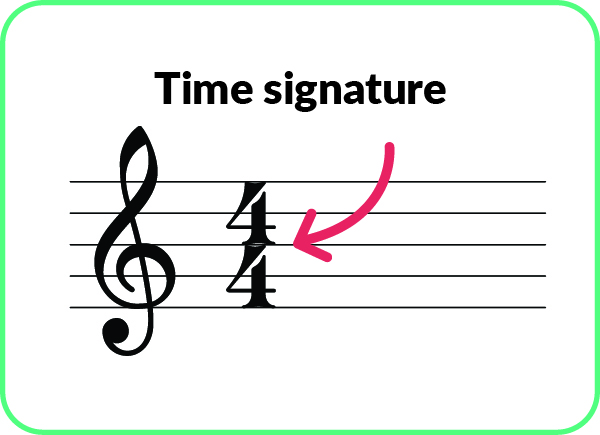
How to read a time signature
Sheet music is split up into bars. Each bar of music is shown by bar lines which help musicians visualize and divide the piece into chunks and phrases. Barlines are vertical lines drawn through the staff and contain a set number of beats dictated by the time signature.
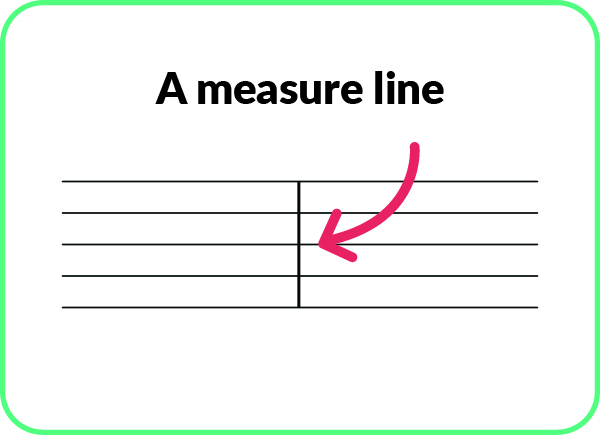
When reading a time signature, the top number of a time signature tells you how many of a certain type of beats there are in a bar. The bottom number denotes the value of those beats. For example 4/4 means four quarter notes in a bar. Just like a fraction.
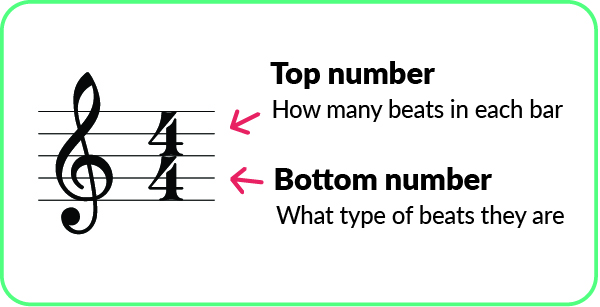
Here is a quick cheat sheet:
| Bottom number | Note value |
| 2 | Half beats |
| 4 | Quarter beats |
| 8 | Eighth beats |
- 4/4 means there are 4 beats in each measure and a quarter note receives one count.
- 2/4 means there are 2 beats in each measure and a quarter note receives one count.
- 2/2 means there are 2 beats in each measure and a half note receives one count.
- 6/8 means there are 6 beats in each measure and an eighth note receives one count.
Within each of these, the beats can still be divided into faster notes, giving us different rhythms. However, printed music will always respect the basic beats, grouping faster notes together into the main beats giving a visual representation of the time feel.
Common time signatures
Just as a language has its popular phrases and words, music has some more prevalent time signatures. These common time signatures form the rhythmic backbone of much of the music we hear.
4/4 time signature
Often referred to as “common time,” the 4/4 time signature is the most widely used in Western music. It is used so often that it can also be represented as a “C” in place of the usual numbers.
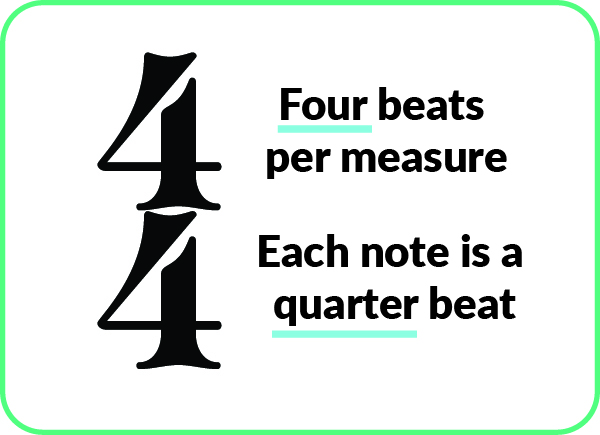
In 4/4. There are four beats in each measure, and each beat corresponds to a quarter note. It’s the pulse behind many of your favorite pop songs, and it’s easy to count – one, two, three, four, repeat. The 4/4 time signature gives music a steady, perfect for getting your foot tapping.
“C” time signature
If you see a mysterious “C” at the beginning of your sheet music, don’t panic. This is just another way of representing the 4/4 time signature. The “C” stands for “common time,” reinforcing just how ubiquitous this time signature is. It’s the same four beats per measure, with the quarter note getting the beat.

2/2 time signature
Moving on to the 2/2 time signature, also known as “cut time” or “alla breve.” This time signature has two beats per measure, with a half note equivalent to one beat. It “cuts” the common time in half. It’s common in faster pieces as it allows musicians to read and play rapid passages more easily due to larger, easier to read, values of beat divisions. It sounds almost the same as 4/4 except it has a stronger accent on the 3rd beat of each measure (the second half note).

Cut time also has an abbreviation that looks like the common time symbol, but with a vertical line cutting through it:

2/4 time signature
The 2/4 time signature is another frequently seen time signature, featuring two beats per measure, with the quarter note getting one beat. It’s a lively time signature that’s particularly popular in polkas, marches and other dance music genres. If you’ve ever danced to a catchy two-step beat, you’ve felt the pulse of the 2/4 time signature.

3/4 time signature
This time signature gives us three beats per measure, with the quarter note getting one beat. It’s the signature behind the graceful waltz and many folk and pop songs. If you count a rhythmic one-two-three, one-two-three, you’re feeling the sway of the 3/4 time. This time signature relies on an accented first beat followed by two active beats, giving this time signature its distinctive sway.

“Valse d’Amelie” is a beautiful waltz with a sad feel to it. Learn it right now on Skoove.
Learn how to play ‘Valse d’Amelie’ on piano. Start a 7 day trial today – no card details required!
3/8 is very like 3/4 except it’s written with three 8th notes per measure instead of three quarter notes each measure. Fur Elise by Ludwig van Beethoven is written in 3/8. Learn to play “Fur Elise” – the beautiful and timeless masterpiece with Skoove.
Learn how to play ‘Für Elise’ by Ludwig Van Beethoven. Start a 7 day trial today – no card details required!
Irregular time signatures
This section explores more advanced rhythms that you might encounter as you progress. If you’re new to time signatures, feel free to skip ahead or bookmark this for later when you’re ready to challenge yourself!
While the common time signatures lay the foundation for much of the music we hear, composers often employ irregular time signatures to create unique rhythmic textures. These unconventional signatures, often featuring odd numbers of beats, inject an unexpected twist into the rhythm, keeping listeners on their toes. Let’s delve into some of these intriguing time signatures.
5/4 time signature
5/4 time feels a little unexpected — like you’re adding an extra step to a familiar rhythm. You might notice it gives music a playful or off-balance vibe, like in the jazz piece ‘Take Five’.

One of the most famous pieces in 5/4 is the jazz standard “Take Five” by Paul Desmond and performed by The Dave Brubeck Quartet.
7/4 and 7/8 time signatures
The 7/4 and 7/8 time signatures bring an even more unusual rhythmic feel. These signatures contain seven beats per measure, but the note value that gets one beat differs. In 7/4, it’s the quarter note, while in 7/8, it’s the eighth note. This difference in note value can create distinct rhythmic effects. Like 5/4, the seven beats can be subdivided into different groupings to vary the rhythmic feel.
 An easy-to-understand example of 7/4 time is Pink Floyd’s ‘Money’. Also, songs in 7/8 time are extremely rare, and there are not many examples, but one example is the A melody part by Japanese pop band Spitz’s ‘Beautiful Fin’. These songs show how musicians create unique identities for their songs by using unusual time signatures.
An easy-to-understand example of 7/4 time is Pink Floyd’s ‘Money’. Also, songs in 7/8 time are extremely rare, and there are not many examples, but one example is the A melody part by Japanese pop band Spitz’s ‘Beautiful Fin’. These songs show how musicians create unique identities for their songs by using unusual time signatures.
Irregular time signatures may feel a bit daunting at first, but fear not! Skoove is here to guide you. Our well-structured lessons simplify these complex signatures, helping you get a feel for these unconventional rhythms and expand your musical horizons. So, gear up to play some quirky beats and make your musical journey even more exciting!
Learn how to play ‘Swan Lake’ by Pyotr Ilyich Tchaikovsky. Start a 7 day trial today – no card details required!
Compound time signatures
Compound time signatures are characterized by a top number that’s divisible by 3, creating a ‘triple feel’ within each beat. Let’s take a look at some common compound time signatures.
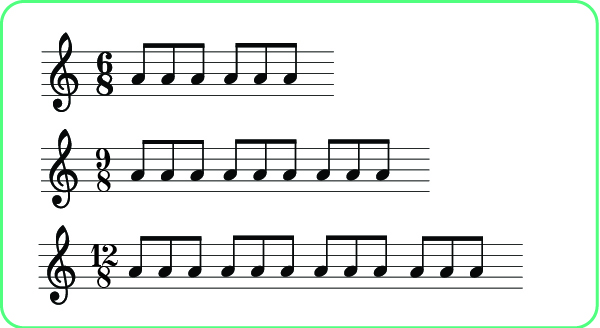
6/8 time signature
Starting off with the 6/8 time signature. This signature has six beats per measure, with the eighth note getting one beat. Rather than feeling like six separate beats, it typically has a ‘two-beat’ feel, with each beat dividing into three smaller beats. It’s often counted as “ONE-and-a, TWO-and-a.
6/8 is a popular time signature in many music genres, from classical symphonies to rock anthems. It’s the time signature behind the Irish jig and many other traditional dances.
Generally, 6/8 time is divided into two groups of three eighth notes. Here is the opening of the “Game of Thrones” theme tune in 6/8 time:
Learn how to play ‘Game of Thrones’ on piano. Start a 7 day trial today – no card details required!
Another great song that’s in 12/8 is “Perfect” by Ed Sheeran.
Learn how to play ‘Perfect’ by Ed Sheeran. Start a 7 day trial today – no card details required!
9/8 time signature
The 9/8 time signature splits the measure into three sets of three eighth notes. So it’s often counted as “ONE-and-a, TWO-and-a, THREE-and-a.”
12/8 time signature
12/8 is another compound time signature. It is also based on the division of beats into groups of three. In 12/8, there are four larger beats each one dividing into three eighth notes. This creates a ‘swinging’ rhythm often found in blues, gospel, and some forms of rock and roll.
It’s worth mentioning that a piece in a compound time could also be written in a simple time using triplets to form the groups of three.
Beethoven wrote the opening of the Moonlight Sonata (op. 27 No 2 in C# minor) in cut time using triplets throughout:
 If we rewrite these measures in 12/8, it will sound exactly the same:
If we rewrite these measures in 12/8, it will sound exactly the same:
 You can learn to play this right now with Skoove:
You can learn to play this right now with Skoove:
Learn how to play ‘Moonlight Sonata’ on piano. Start a 7 day trial today – no card details required!
3/8 time signature
Finally, we have the 3/8 time signature. It’s similar to 6/8 but feels faster because it only has one larger beat that divides into three eighth notes. It’s often used for lively, quick music pieces.
Compound time signatures can add a unique rhythmic flavor to your piano playing. Fur Elise by Ludwig van Beethoven is written in 3/8. Learn to play “Fur Elise” – the beautiful and timeless masterpiece with Skoove.
Although it’s the same as 3/4 in essence, you might assume that the piece will be played a bit faster in 3/8. But always be guided by any instructions at the beginning of the piano sheet music, such as “Moderato” (meaning moderate speed) or “Presto” (meaning fast).
Simple time vs. Compound time
Even if two time signatures seem similar, like 3/4 and 6/8, they create very different rhythmic feels. Here’s a quick comparison to help you “feel” the difference between Simple and Compound time.
| Feature | 3/4 (Simple time) | 6/8 (Compound time) |
|---|---|---|
| Type | Simple | Compound |
| Beats per measure | 3 beats | 2 beats (each subdivided into 3) |
| Main beat unit | Quarter note (♩) | Dotted quarter note (♩.) |
| Counting method | 1 – 2 – 3 | 1-and-a 2-and-a |
| Rhythmic feel | Straight, balanced (like a waltz) | Flowing, lilting or “rolling” rhythm |
| Example genre | Waltz, folk music | Jigs, ballads, pop ballads |
| Famous example | Valse d’Amelie | Hallelujah, Game of Thrones Theme |
| Visual representation | ♩ ♩ ♩ | ♩ ♪ ♪ ♩ ♪ ♪ |
How it feels
3/4 (Simple time):
You count three steady beats in each measure:
ONE – two – three | ONE – two – three
This creates a clear, balanced rhythm, often associated with the graceful sway of a waltz.
6/8 (Compound time):
You feel two main beats, each naturally dividing into three smaller pulses:
ONE-and-a | TWO-and-a
This gives the music a smooth, flowing, and rolling character, commonly found in ballads, jigs, and dance-like pieces.
| Time signature | Beat grouping | Typical feel |
|---|---|---|
| 3/4 | 1 – 2 – 3 | Waltz |
| 6/8 | 1-2-3 / 4-5-6 | Irish Jig |
| 4/4 | 1 – 2 – 3 – 4 | Pop/Rock Songs |
Odd time signatures
This section explores more advanced rhythms that you might encounter as you progress. If you’re new to time signatures, feel free to skip ahead or bookmark this for later when you’re ready to challenge yourself!
A composer can make a choice when it comes to time signatures – as you can see, there is more than one way to write a piece of music to convey the sound you want.
There are pieces of music written in much more adventurous time signatures. For instance, the gaming music “The Legend of Zelda: Ocarina of Time – Ganandorf’s Battle Theme” was written in a 23/16. This means there are 23 beats per measure and the sixteenth note receives one beat!
A composer can create whatever time signature they need. However, the person who is going to be reading and interpreting the music notation should be considered and clarity should be the aim.
“Praeludium 15 in G major” by J. S. Bach is written with a different time signature for each hand. Namely, 24/16 for the right hand and common time for the left.
Example songs by time signature
Now that you understand how different time signatures work, why not experience them in action? Here’s a list of well-known easy songs you can try, each showcasing a different rhythm. You’ll start to “feel” the pulse of each time signature as you play or listen!
| Time signature | Example song | Style/Genre | Where to practice |
|---|---|---|---|
| 4/4 (Common Time) | Let It Be – The Beatles | Pop/Rock | Play on Skoove |
| 3/4 | Valse d’Amelie | Waltz/Soundtrack | Learn with Skoove |
| 6/8 | Hallelujah – Leonard Cohen | Folk/Ballad | Start lesson |
| 12/8 | Perfect – Ed Sheeran | Pop Ballad | Practice on Skoove |
| 5/4 | Take Five – Dave Brubeck | Jazz | Explore rhythm |
| 7/4 | Money – Pink Floyd | Rock/Progressive | Try it here |
| 3/8 | Für Elise – Beethoven | Classical | Play now |
Key takeaways
- The time signature indicates how many counts are in each measure and which type of note will receive one count.
- The top number is commonly 2, 3, 4, or 6.
- The bottom number is either 4 or 8.
- Simple time signatures divide music into groups of 2 and compounds divide music into groups of 3.
What to do with all this time?
Now that you’ve explored the world of time signatures and how they shape the rhythm of music, you’re well on your way to mastering beats and measures! Understanding time signatures is crucial for improving your piano playing, but there’s much more to learn. With Skoove, you can deepen your understanding of rhythms and get hands-on practice through guided lessons and fun songs. Whether you’re just starting out or looking to fine-tune your skills, Skoove is here to support you on your musical journey.
Author of this blog post
Vicki Young

Vicki Young is a pianist and singer with a degree in Music from the University of Sheffield. She lives in London, UK with her husband and son. Vicki is a communications and marketing freelancer who has worked with a range of organizations across the music and charity sectors.
Published by Lydia Ogn from the Skoove team







